VisiCalc - The Early Days
Peter Jennings
April, 2003
![Apple ][ VisiCalc 1979 Apple ][ VisiCalc](visicalcscreen.gif) On April 8, 2003, Dan Bricklin, Bob Frankston, and Mitch Kapor gathered with Charles Simonyi to
speak about the Origins and Impact of VisiCalc.
This got me thinking about those early days and my own first encounters with the program.
On April 8, 2003, Dan Bricklin, Bob Frankston, and Mitch Kapor gathered with Charles Simonyi to
speak about the Origins and Impact of VisiCalc.
This got me thinking about those early days and my own first encounters with the program.
By the summer of 1978, Microchess was available on all of the popular personal computers of the day, the S-100 bus machines, the TRS-80 and the Commodore PET. Micro-Ware had a booth at PC-78 in Atlantic City and the cassettes were flying off the table. Carl Helmers, editor of Byte Magazine, came by and introduced me to someone I should meet because “we have a lot in common”. This turned out to be Dan Fylstra, at the time, an MBA student at Harvard, a writer for Byte, and a 6800 programmer. I didn't remember at the time, but later I discovered that Dan had been the third person to order Microchess for the Kim-1 when it was announced in 1976.
Dan and I had lunch together and he told me about Personal Software, his small company distributing programs for personal computers. He quickly asked if he could add Microchess to the product line. So began my relationship with Personal Software.
Dan and I spent long hours on the phone between Boston and Toronto discussing the future of personal computers, software, and software publishing. Before long we had decided to merge our companies. There would be a combining of assets for shares, and I would receive a royalty for my Microchess.
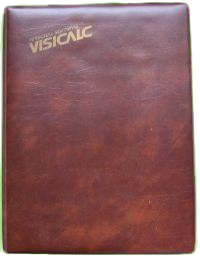 It was not long after this
that Dan told me about Dan Bricklin and his idea for an electronic calculating ledger. It was clearly
a revolutionary idea and we knew it would be an important element of our product line. We didn't realize how important until
much later. Not long after, I flew down to Boston and met Bob Frankston and Dan Bricklin. We went out to a
Chinese restaurant and discussed, among other things, possible names for the new product. Visible Calculator
was one of the leading options, as was Electronic Ledger, but we finished dinner without having made a decision.
We did agree that VisiCalc sounded too much like a vitamin.
It was not long after this
that Dan told me about Dan Bricklin and his idea for an electronic calculating ledger. It was clearly
a revolutionary idea and we knew it would be an important element of our product line. We didn't realize how important until
much later. Not long after, I flew down to Boston and met Bob Frankston and Dan Bricklin. We went out to a
Chinese restaurant and discussed, among other things, possible names for the new product. Visible Calculator
was one of the leading options, as was Electronic Ledger, but we finished dinner without having made a decision.
We did agree that VisiCalc sounded too much like a vitamin.
In Boston, Dan Fylstra was negotiating a contract with Bricklin and Frankston. After each session, he would call me and we would go over the terms that had been agreed and those that were still on the table. The most contentious issue was the royalty percentage. At that time, there were no standards for what royalty should be paid for software. Dan and I had negotiated the Microchess royalty based on the profit I was making on units shipped by Micro-Ware at the lowest wholesale price, a little over 30%. This was undoubtedly a factor in deciding what royalty Bob and Dan should receive for VisiCalc. The other issue was an advance on royalties to cover some of the development costs. Bob wanted to use a cross-compiler on a timeshare system to do the development using a macro language he had created for the 6502. It was estimated that this would cost $4-5,000 per month. We agreed to cover these costs. But if I received my royalties for Microchess, there would not be sufficient cash flow available. I agreed to postpone the royalties owed to me until the company was in a position to pay them. Thus, in a very real way, Microchess sales helped finance the development of VisiCalc.
After long debates about whether our newly merged company should be in Boston or Toronto, we had decided that it should be where the action was, in Silicon Valley. On the first weekend in January, 1979, Dan and I attended the Consumer Electronic Show in Las Vegas. After the show, Dan returned to Boston to attend classes at Harvard and manage the rapidly growing business still being run out of his Allston apartment. I headed up to Sunnyvale to find office space and make initial contacts with bankers, suppliers, and industry people. During my meeting with Regis McKenna, who we were trying to convince to become our ad agency and public relations firm, Dan called to tell me that Microchess sales to date had now exceeded one million dollars.
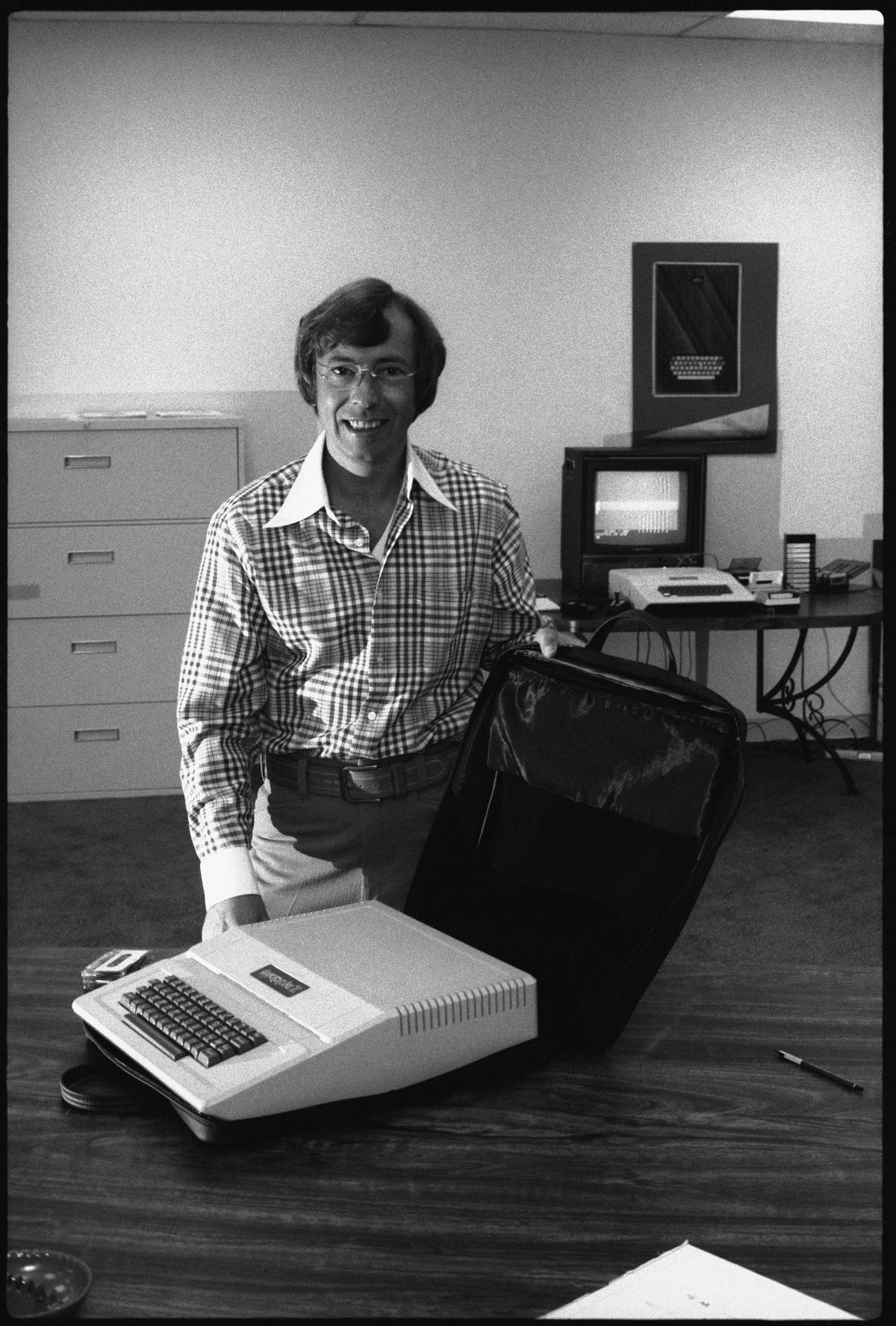 It was on this trip that I met with Mike Markkula, then Chairman of Apple Computer. One of the reasons for
meeting was to demonstrate a very early version of VisiCalc. I loaded it onto his computer and created
the standard P&L demo in a matter of seconds. At this time there were no file commands, so I couldn't have
loaded a canned spreadsheet if I had wanted to. Mike watched the demonstration without great enthusiasm.
Then, he picked a diskette off his desk and loaded “something really interesting”. He had been writing a checkbook
program in Apple Basic. I tried to explain that VisiCalc could be a checkbook program as easily as it was
a budgeting program, but he didn't really get it. He was too excited by his first program.
It was on this trip that I met with Mike Markkula, then Chairman of Apple Computer. One of the reasons for
meeting was to demonstrate a very early version of VisiCalc. I loaded it onto his computer and created
the standard P&L demo in a matter of seconds. At this time there were no file commands, so I couldn't have
loaded a canned spreadsheet if I had wanted to. Mike watched the demonstration without great enthusiasm.
Then, he picked a diskette off his desk and loaded “something really interesting”. He had been writing a checkbook
program in Apple Basic. I tried to explain that VisiCalc could be a checkbook program as easily as it was
a budgeting program, but he didn't really get it. He was too excited by his first program.
In 1979 I demonstrated VisiCalc to hundreds of people who had never seen a spreadsheet before. The range of responses was very interesting. In general, programmers and people who understood how difficult it is to make computers do things reacted with awe and instant respect. On the other hand, non-computer-literate people tended to be nonchalant. They just thought that computers could do that sort of thing and it was no surprise to them at all. They probably also thought you could just type a request for information about any topic into the computer and it would provide you with an answer, too. They would not have been the least surprised to see Google demonstrated.
The earliest test versions of VisiCalc all lacked a file system. It was understood that for optimal performance and to ensure maximum available memory it would be better to access the disk drive directly than to use any part of Apple DOS. Fortunately, I had recently disassembled the Apple disk operating system in order to create efficient file handling routines for Micro-ADE. I was able to provide Bob Frankston with source listings of fully working low level routines that he could incorporate into VisiCalc. That was my minor contribution to the VisiCalc source code. Later this same expertise would come into play as we developed a copy protection mechanism for the first release.
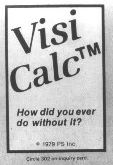 By April, VisiCalc was fairly advanced and reliable. Although it could not yet print, the calculation
functions were stable and it could be used for real calculations. Faced with many decisions about my
tax return for 1978, I created the world's first spreadsheet to do a tax return and applied the famous what-if
queries to the data. Although there was no print facility, I was able to use some of my own debug programs
to save the screens to the printer for delivery to my accountant. [Note: I have just learned that
Bob Frankston also used VisiCalc to do his 1978 tax return. In the process, he discovered he needed
a lookup table for the tax rates, and incorporated the @lookup command then and there. One of the reasons
VisiCalc was so complete and elegant in its first release is that we were all using the program for so
long during the development phase.]
By April, VisiCalc was fairly advanced and reliable. Although it could not yet print, the calculation
functions were stable and it could be used for real calculations. Faced with many decisions about my
tax return for 1978, I created the world's first spreadsheet to do a tax return and applied the famous what-if
queries to the data. Although there was no print facility, I was able to use some of my own debug programs
to save the screens to the printer for delivery to my accountant. [Note: I have just learned that
Bob Frankston also used VisiCalc to do his 1978 tax return. In the process, he discovered he needed
a lookup table for the tax rates, and incorporated the @lookup command then and there. One of the reasons
VisiCalc was so complete and elegant in its first release is that we were all using the program for so
long during the development phase.]
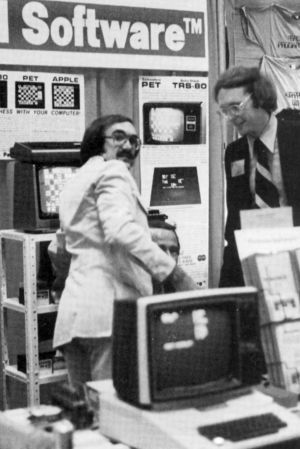 In May, we had a booth at the West Coast Computer Faire in San Francisco. The WCCF coincided with our move from
Boston to California. We were operating out of our new offices, but there was no furniture. It also coincided with
the gasoline shortage which created mammoth lines at the pumps. We took the train from Palo Alto to San Francicso
for the show.
In May, we had a booth at the West Coast Computer Faire in San Francisco. The WCCF coincided with our move from
Boston to California. We were operating out of our new offices, but there was no furniture. It also coincided with
the gasoline shortage which created mammoth lines at the pumps. We took the train from Palo Alto to San Francicso
for the show.
We rented a special room to secretly demonstrate VisiCalc to key industry luminaries. Steve Jobs, Steve Wozniak, Adam Osborne, Ted Nelson, Vern Raburn, Ben Rosen, Portia Isaacson, Chuck Peddle and many others were treated to early demonstrations by Dan Bricklin, Dan Fylstra or myself. After each demonstration we tried to pick their brains for marketing advice. The key question was what should we charge. The range of suggestions was $25 to $400 a copy, with most of the suggestions at the low end of the range.
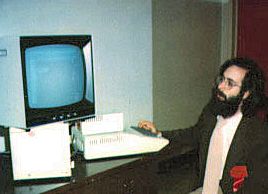
That summer, Personal Software was permanently installed on Weddell Drive in Sunnyvale. We placed teaser ads in Byte Magazine. VisiCalc, How did you ever do without it? We also decided on a packaging solution that would be practical and inexpensive to produce, yet would inspire confidence and offer a business-like appearance in contrast to our existing line of game products, packaged in greeting card boxes with clear plastic lids. We settled on the brown binders with gold embossed printing which were readily available and represented a giant step up in quality from the other products on the shelves in the computer stores.
It was only a few months after we shipped that almost all business software from any vendor came packaged in
identical brown binders. This same experience would be repeated a few years later when we moved
to box packaging with professional graphics.
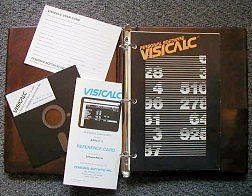
Today, one might wonder why it took almost a year to bring out the VisiCalc product. First, Bob and Dan in Boston were working night and day to perfect the software and optimize it for maximum performance on an Apple ][ with 32 to 48K of memory. (I don't think it ran on the 16K models). Meanwhile, Dan and I in Sunnyvale were doing our best to create a professional product with documentation to match the software quality. We hired a professional writer to write the manual (which we paid for, rejected and rewrote), printed it on high quality glossy stock, and enclosed a well conceived and useful reference card. This professional approach to software for personal computers was unique at the time.
I remember clearly a day in August when Dan Fylstra and I were exploring various business plans. VisiCalc was almost ready for shipment. As we generated spreadsheet after spreadsheet and manipulated the many variables inherent in different strategies, we realized with clarity the power of the tool we had at our disposal. We could change assumptions, change costs, change formulae and instantly see the effect it would have on profitability and cash flow. We realized that startup companies everywhere were doing the same thing without VisiCalc to help them. Simultaneously we asked the rhetorical question, “Should we keep this advantage to ourselves?”. Of course not, but it was an interesting thought and a clear example of the power VisiCalc would grant to analysts and planners everywhere.
It is especially noteworthy that both Dan and I had often written quick disposable programs in the handiest available language to do this kind of analysis before. Four years earlier, I had made a living selling financial planning software on a timesharing system, and advocating the use of APL to perform exactly the functions done visually by VisiCalc for us on that day. I was very glad I had left Comshare to pursue the personal computer industry opportunity. We understood the power of the spreadsheet.
On the very day that VisiCalc first shipped to customers, I sat at my desk and pondered what was missing in VisiCalc. By now, I had created more VisiCalc spreadsheets than any user except Bob and Dan. Many of the features and changes I had suggested along the way had been incorporated. Other ideas were too complicated or too late for the first version. I filled a blank sheet of paper with the requirements for VisiCalc II. When Mitch Kapor released Lotus 1-2-3 in January 1983, many of the items on that list were incorporated in his product. They were not yet in VisiCalc and that was a major factor in Lotus’ success and VisiCorp’s demise as well as an issue leading to the later litigation between Software Arts and VisiCorp.
The first copy of VisiCalc for the Apple ][ (Version 1.37) went out the door on October 17, 1979. By the end of the month, we had shipped 1293 copies. As the sales figures grew, VisiCalc became a household word. It even appears in the Oxford English Dictionary.
| Oct | Nov | Dec | Jan | Feb | Mar |
| 1293 | 1077 | 1888 | 1903 | 785 | 687 |
With two killer apps, Microchess and VisiCalc, sales figures grew with the personal computer industry. For five straight years, from 1979 through 1983, Personal Software/VisiCorp was the largest software company, beating Microsoft each year.
The Importance of VisiCalc
Programming for the Masses.
VisiCalc was the software which brought the power of the personal computer to the common man. Before its introduction, computers, even personal computers, could only be programmed by people who had made the effort to learn a programming language. Users without programming skills were locked into using the existing applications. What they could not do was to solve problems. VisiCalc unlocked the power of the computer as a problem solving device to those who did not wish to learn programming skills and in such a way that it did not seem like programming at all. Even today, most users of spreadsheet applications do not think of themselves as programmers. But that is exactly what they are doing every time they type a formula.
The Power of Simulation.
The power of VisiCalc did not stop with the creation of a completed spreadsheet. The freedom to change any number, anywhere on the page, and see the computed effects, allowed the user to experiment with possibilities in a way which is totally intuitive. As a business planning tool, it automatically created an understanding of the sensitive and insensitive factors which was almost impossible to appreciate in any previous way. The resulting amplification of business intelligence and a heightened awareness of how a business operates becomes embedded in the managers psyche and affects decision making far beyond the expected results of the problem being solved on the screen.
Of course, this power is not restricted to business decision makers. Individuals could plan their budgets, scientists could analyse and simulate data, engineers could perform calculations, and on and on. In every case the ability to ask “what if?” brings out the inner child who wants to play with the data and the result is inspiration, creativity and effortless learning.
Productivity and Power
The combined effect of this power over data in the hands of individuals is an amplification of productivity. It is no wonder that the availability of VisiCalc justified the purchase of a computer. The productivity gains were real and quantifiable.
Before the release of VisiCalc for the TRS-80, I visited Tandy in Fort Worth. It was not a great surprise to see a few Apple computers on managers desks, purchased specifically to run VisiCalc for budgeting and planning. When we negotiated VisiCalc for the IBM PC (it was one of the few programs available on launch day), the managers were already competent VisiCalc users. There must have been some Apples in their office, too.
Almost everyone involved in the personal computer revolution was a child of the sixties. We arrived on the scene with a mission to change the world. The tool we chose was the capability of computers to empower people in ways never before imagined. VisiCalc was one of the keys to that empowerment. Although my contribution was minor and peripheral, participating in bringing VisiCalc into the world was most satisfying because it fulfilled that mission in a most direct and unambiguous way.
Links
Everything about VisiCalc by Bob and Dan
Dan Bricklin’s History of VisiCalc
(Most of the pictures are from his site).
Bob Frankston on Implementing VisiCalc
Download PC VisiCalc, vintage 1982
Creation and Destruction of VisiCalc by Ed Esber
Was VisiCalc the first computerized spreadsheet?"
VisiCalc Case Study in Corporate Strategy. Collis and Montgomery.
VisiCalc Case Study by Rumelt and Watt, Anderson School of Management, UCLA. [pdf]
|
The word VisiCalc is not in the Oxford English Dictionary as an entry, but it does appear
in the quotations for the verb, download.
The term “spread sheet” predates VisiCalc. Popular usage led to the combining of the words into the new word spreadsheet. Early publications at Software Arts and Personal Software did not include the term. Nobody seems to remember if we referred to spreadsheets in our conversations at the time. Dan Bricklin used the working title Calculating Ledger in early program documentation. Richard Mattesich has documented the history of the use of the term spread sheet dating back to 1952 for accounting and 1961 for computerized spread sheets. |
Interesting extracts from the OED (CD version 3):
download, v.
spreadsheet
APPENDED FROM ADDITIONS 1993
© 2002 Oxford English Dictionary on CD Version 3.